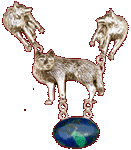| O Shortly following Atsidi Sani's beginning Navajo silversmithing, the craft spread across the area. He taught his sons and they taught others. The craft made its appearance in Zuni jewelry ca. 1872. Atsidi Chon (Ugly Smith) taught his close Zuni friend, Lanyade, the skills. The Zuni were already skilled in metal working making items in copper, brass and iron. Research shows that a forge existed in Zuni in 1852. It is reported (see Rosneck and Stacy) that Lanyade paid Atsidi Chon "one good horse" for his instruction.
Lanyade learned the trade well. He began touring the various pueblos selling his Zuni jewelry. While on Hopi First Mesa at Sichomovi, he taught the first Hopi silversmith, Sikyatala, the skills. As Lanyade was taught by a Navajo and the Hopi taught by Lanyade all the Sterling Silver jewelry of the period was Navajo in style. As a side note this is why provenance (history of origin-ownership) is so important for 19th century indian jewelry in properly identifying its origin. It's too easy to say that because it looks like Navajo work it is therefore of Navajo origin.
During these early years the use of solder was learned and developed. Accompanying this was the skills of making silver dies. The former permitted the artistic and permanent joining of two or more metal pieces resulting in a multitude of design possibilities and the setting of stones. Die making was probably adopted from the many leather tooling dies that existed and were used by Spanish, Mexican and later Indians in both leather work as well as tin smithing.
As the years progressed the styles that were basically of Navajo origin were gradually modified by their pueblo students. For example: the Zuni, since prehistoric times, were excellent lapidaries. These skills slowly changed their work to the fine inlay and channel inlay we have come to associate with them. However, the Hopi change occurred a bit more abruptly. In 1938 the Museum of Northern Arizona in Flagstaff, Arizona, working with Hopi silversmiths, Paul Saufkie and Fred Kabote, began a program of developing a style that was exclusively Hopi. The work was interrupted by World War II. Following the war a government grant helped a silversmith training program with the Hopi Guild. The "overlay" technique they created involved the cutting of designs in a heavy gauge silver sheet and then soldering this to a solid silver sheet. The designs were usually adapted from the pottery shards found in the Sikyatki Pueblo ruins of the 15th and 16th centuries. These pre-Hopi designs were mostly bird motifs. The Hopi Guild also used kachina symbols, animal and clan motifs.
Today's Indian silversmiths are in many cases also goldsmiths and lapidaries as well. They cross tribal design boundaries with a will and with abandon. No longer can one look at a piece and say "It's Zuni jewelry style so it must be Zuni made." The artist of today may incorporate in a single piece all the styles available as well as his or her own innovation. Indian jewelry today transcends tribal styles. for more on Native American Indian Symbolizm, Visit: |





